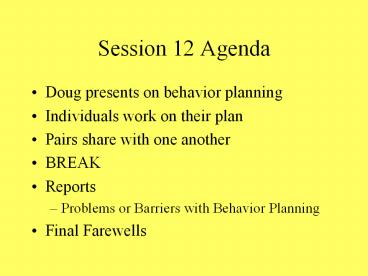Session 12 Agenda - PowerPoint PPT Presentation
1 / 19
Title:
Session 12 Agenda
Description:
Antecedent Strategies Self- Management Actively involving the student in identifying, monitoring, ... peer to peer skills, anger management, I statements, etc.). – PowerPoint PPT presentation
Number of Views:56
Avg rating:3.0/5.0
Title: Session 12 Agenda
1
Session 12 Agenda
- Doug presents on behavior planning
- Individuals work on their plan
- Pairs share with one another
- BREAK
- Reports
- Problems or Barriers with Behavior Planning
- Final Farewells
2
Building Behavior Plans for Students
Doug Cheney University of Washington Seattle,
WA www.depts.washington.edu/beacons1
3
Deciphering Difficult Behavior The Behavior
Pathway
It is as easy as ABC
4
Possible Functions
- To Get/Gain
- To Avoid/Escape
- Sensory Stimulation
- (ONeill et al., 1996)
- Power/Control
- Escape/Avoidance
- Assertion/Differentiation
- Acceptance/affiliation
- Self-expression
- Gratification
- Justice/revenge
- (Neel Cessna, 1992)
5
Summary Statement
Antecedent Behavior Consequence
When A occurs B begins, which results in C.
Once a summary statement has been determined the
team must take steps to determine whether it is
accurate or not
6
Summary Statements Presenta Story or Narrative
Antecedent Problem Behavior Maintaining
Consequence When given an academic demand that
is difficult or confusing to Cassandra, she
becomes off task and then disruptive which
results in gaining attention while avoiding the
task.
7
PBS Strategies are determined for each link in
the Behavior Pathway
These strategies are defined, data collection
measures are determined, and responsibilities
clarified, becoming the PBS Plan.
8
The Complete Behavior Pathway
Behaviors
Setting Event
9
Cassandras Behavior Pathway Summary
Behaviors
Maintaining
1/10/02
Desired Increase On Task Behavior
Consequence Reinforcement and attention
Setting Event IEP,Low Academic Skills, Perceived
Task Difficulty
Antecedent Academic Demand, Directions
Consequence Peer/Adult Attention, Control Work
Avoidance
Problem Disruption, Off Task
Acceptable Be in seat with less disruption
10
Key Strategies in FBA (Stage Quiroz, 1998)
- Antecedent Strategies
- Cueing Prompting
- Self-monitoring
- Instructional Modifications
- Behavior Teaching
- Social Skills Instruction
- Consequent Strategies
- Differential Attention
- Individual or Group Contingencies
11
Antecedent StrategiesStrategies that PRECEDE a
behavior and serve to decrease or
divert it.
- Stimulus Cues-
- Giving the student clear cues, signals, or
reminders - Presenting an outline of expectations before the
behavior will be required, - Set the student up for success (i.e. The teacher
says, Remember students who are in their seats
quietly will be asked to line up for recess.).
12
Antecedent Strategies
- Instructional Modifications-
- Changing instructional presentation or work
requirements of a student to make it easier for
the student to successfully complete a task or an
assignment. - Examples (requiring only 1/2 the number of math
problems, tape recording story ideas etc.).
13
Antecedent Strategies
- Self- Management
- Actively involving the student in identifying,
monitoring, and reinforcing their use of positive
skills - Example a student circles a smiley face each
time he completes an assignment throughout the
day. The smiley faces are then counted and goals
set for reinforcement/acknowledgement.
14
Behavior Teaching Strategies
- Give the student a clear understanding of what
behaviors are expected and appropriate for
success. - These behaviors are designed to replace the
problem behavior and meet student needs. - Define It, Teach It, Model It, Practice It, and
Reinforce It- regularly for Success!
15
Behavior Teaching Strategies
- Social Skills Instruction
- Providing the student with direct training on
necessary prosocial skills which address
particular problem areas for the student - Examples (classroom or non-classroom
expectations, peer to peer skills, anger
management, I statements, etc.).
16
Behavior Teaching Strategies
- Note Remember, before you can expect a student
to demonstrate a behavior you must - Define It, Teach It, Model It, Practice It, and
Reinforce It- regularly!
17
Consequent Strategies Strategies that occur
AFTER a behavior and increase or maintain it.
- Differential Reinforcement (Attention) -
- Providing attention and praise for appropriate
behaviors while not responding to problem ones - Example The teacher sits by a student when she
sees the student working at the assignment rather
than when the student is not working.
18
Consequent Strategies
- Group Contingencies-
- Used when a student CAN perform a skill but
chooses not to and the student is motivated by
peer attention. - Creating a plan in which a group earns a specific
reinforcer when a student or the group reaches
criteria - Example Earning a pizza party after students
have turned in all assignments for 2 weeks
19
Your Turn
- Individually attempt to complete the Behavior
Support Plan Form. - Share in a Pair, and discuss each others student
with a partner. - Identify problems/barriers for completing the
final assignment































